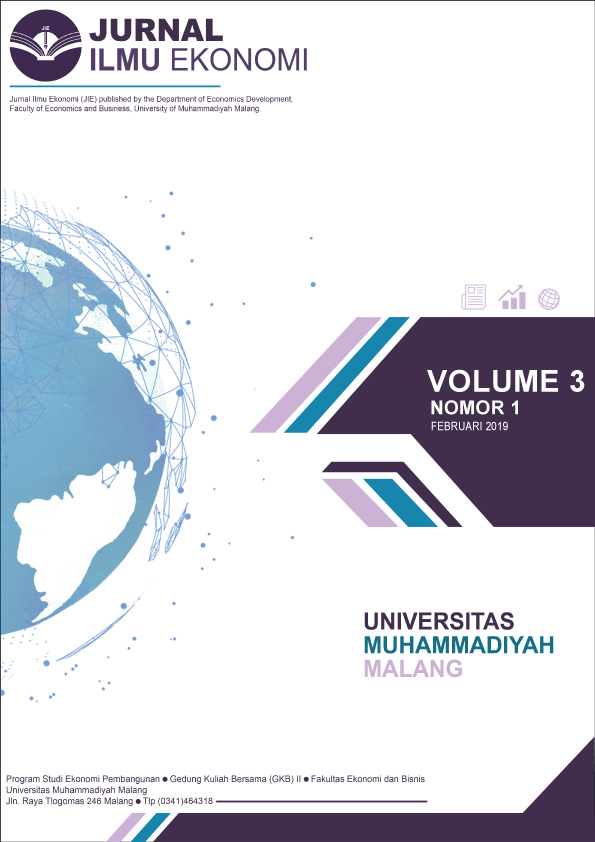ANALISIS DETERMINAN PROFITABILITAS BANK SYARIAH DI ASEAN (INDONESIA, MALAYSIA, BRUNEI DARUSSALAM)
DOI:
https://doi.org/10.22219/jie.v3i1.9546Keywords:
CAR, NPF, FDR, BOPOAbstract
This research aims to analyze the determinant of the profitability of Sharia banks in ASEAN that took 3 countries, namely Indonesia, Malaysia, and Brunei Darussalam. This study uses 24 sharia banks in 3 ASEAN countries. The sampling used in this research is the purposive sampling method, which is the uptake based on the criteria that have been established. This method of research is quantitative. The data collection method used is with the documentation. The data required is secondary data from the financial reporting data of each sharia bank in Indonesia, Malaysia, and Brunei Darussalam in 2013-2017. The data analysis technique is a data panel regression analysis technique. The results of the study showed that on average the ROE percentage of Sharia banks in Indonesia reached 0.81%. For simultaneous testing also due to the value of F-count 34.75609 ≥ F-table 3.13 Then it can be concluded that H0 rejected and H1 accepted, which means that the free variables i.e. CAR, FDR, NPF, and BOPO are influential simultaneously and together against variable bound is ROE Bank Syariah in Indonesia, Malaysia, and Brunei Darussalam in 2013-2017.Downloads
References
Abdullah, M. F. (2003). Manajemen Perbankan. Malang: UMM Press.
Abdullah, M. F. (2005). Manajemen Perbankan: Teknik Analisis Kinerja Keuangan Bank. Malang: UMM Press.
Arthesa, A. & Handiman, E. (2009). Bank dan Lembaga Keuangan Bukan Bank. Jakarta: PT. Macanan Jaya Cemerlang.
Boediono. (1990). Ekonomi Moneter. Yogyakarta: BPFE.
Hassan, M. K., & Bashir, A.H. M. (2005). Determinants of Islamic Banking Profitability. Islamic Perspectives on Wealth Creation, 44(8), 118–140.
Kurniawati, E. T. (2017). Analysis Of The Influence Of The Ratio Of Profitability Against The Growth Of The Assets Of Islamic Banks In Indonesia. The UMM Economics Innovation Working Paper Series, 19–20.
Lukman, D. (2009). Manajemen Perbankan. Jakarta: Ghalia Indonesia.
Lukman, S. (2000). Manajemen keuangan perusahaan. Jakarta: PT. Raja Grafindo.
Malik, N. (2010). Industri Perbankan Indonesia Pasca Implementasi Api 2004. Ekonomika-Bisnis, 01(01), 93–110.
Muhammad. (2005). Manajemen Bank Syariah. Yogyakarta: UPPAMP YKPN.
Yuni, P. (2018). Analisis Pengaruh CAR, NPF, FDR, BOPO, BI rate dan Inflasi terhadap Tingkat Profitabilitas Perbankan Syariah di Indonesia Periode 2011-2017 (Skripsi). Universitas Islam Indonesia, Yogyakarta.
Suhada, M. (2009). Modul Short Course Bank Syariah. Yogyakarta: STEI.
Sukirno, S. (2011). Makroekonomi Teori Pengantar (Ketiga ed.). Jakarta: Rajawali Pers.
Suryani, L. (2006). Analisis Kinerja Bank Syariah Mandiri. Majalah Ekonomi dan Komputer, 2.
Susilowibowo, J. (2014). Pengaruh Inflasi, BI Rate, CAR, NPF, BOPO Terhadap Profitabilitas Bank Umum Syariah Periode 2008-2012. Jurnal Ilmu Manajemen, 2(3), 760–763.
Wibowo, E. S. & Syaichu, M. (2013). Analisis Pengaruh Suku Bunga, Inflasi, CAR, BOPO, NPF terhadap Profitabilitas Bank Syariah. Diponegoro Journal of Management, 2(2), 1–10.
Yuhanah, S. (2016). Pengaruh Struktur Pasar Terhadap Profitabilitas Perbankan Syariah di Indonesia. Esensi, 6(1). https://doi.org/10.15408/ess.v6i1.3138
Yuli, S. B. C. (2012). Kualitas Layanan Bagi Nasabah di PT. Bank Syariah Mandiri Cabang Malang. Jurnal Humanity, 7(2), 83–97.
Zuhroh, I. (2012). Penguatan Laboratorium Bank Syariah Untuk Mendukung Perkembangan Industri Keuangan Syariah. Ekonomika Bisnis, 03(1), 13–28.
Downloads
Published
How to Cite
Issue
Section
License
Copyright (c) 2020 Jurnal Ilmu Ekonomi JIE

This work is licensed under a Creative Commons Attribution-NonCommercial-ShareAlike 4.0 International License.
Authors who publish with this journal agree to the following terms:
- For all articles published in the JIE (Jurnal Ilmu Ekonomi), copyright is retained by the authors. Authors give permission to the publisher to announce the work with conditions. When the manuscript is accepted for publication, the authors agree to the automatic transfer of non-exclusive publishing rights to the publisher.
- Authors retain copyright and grant the journal right of first publication with the work simultaneously licensed under a Creative Commons Attribution-NonCommercial-ShareAlike 4.0 International License that allows others to share the work with an acknowledgement of the work's authorship and initial publication in this journal.
- Authors are able to enter into separate, additional contractual arrangements for the non-exclusive distribution of the journal's published version of the work (e.g., post it to an institutional repository or publish it in a book), with an acknowledgement of its initial publication in this journal.
- Authors are permitted and encouraged to post their work online (e.g., in institutional repositories or on their website) prior to and during the submission process, as it can lead to productive exchanges, as well as earlier and greater citation of published work (See The Effect of Open Access).
This is an open access article and licensed under a Creative Commons Attribution-NonCommercial-ShareAlike 4.0 International License








